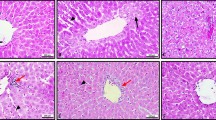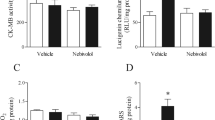Abstract
It is widely accepted that oxidative stress plays a central role in alcohol-induced pathogenesis. The protective effect of binaphthyl diselenide (NapSe)2 was investigated in ethanol (Etoh)-induced brain injury. Thirty male adult Wistar rats were divided randomly into five groups of six animals each and treated as follows: (1) The control group received the vehicle (soy bean oil, 1 mL/kg, p.o.). (2) Ethanol group of animals was administered with ethanol (70% v/v, 2 mL/kg, p.o.). (3) (NapSe)2 1 mg/kg, 1 mL/kg plus ethanol 70% (v/v, 2 mL/kg, p.o. (5) (NapSe)2 10 mg/kg, 1 mL/kg) plus ethanol 70% (v/v, 2 mL/kg, p.o). After acute treatment, all rats were sacrificed by decapitation. Evidence for oxidative stress in rat brain was obtained from the observed levels of thiobarbituric acid reactive species, of non-protein thiol (NPSH) groups, and of ascorbic acid, as well as from the activities of catalase (CAT) and of superoxide dismutase (SOD). (NapSe)2 compensated the deficits in the antioxidant defense mechanisms (CAT, SOD, NPSH, and ascorbic acid), and suppressed lipid peroxidation in rat brain resulting from Etoh administration. It was concluded that ethanol exposure causes alterations in the antioxidant defense system and induces oxidative stress in rat brain. (NaPSe)2 at 5 mg/kg restored the antioxidant defenses in rat brain and mitigated the toxic effects of alcohol, suggesting that could be used as a potential therapeutic agent for alcohol-induced oxidative damage in rat brain.






Similar content being viewed by others
References
Calabrese V, Testa G, Ravagna A, Bates TE, Stella AM (2000) HSP70 induction in the brain following ethanol administration in the rat: regulation by glutathione redox state. Biochem Biophys Res Commun 269:397–400
Akyol Z, Bartos JA, Merrill MA, Faga LA, Jaren OR, Shea MA, Hell JW (2004) Apo-calmodulin binds with its C-terminal domain to the N-methyl-D-aspartate receptor NR1 C0 region. J Biol Chem 279:2166–2175
Halliwell B (2006) Oxidative stress and neurodegeneration: where are we now? J Neurochem 97:1634–1658
Calişkan AM, Naziroğlu M, Uğuz AC, Ovey IS, Sütçü R, Bal R, Calişkan S, Ozcankaya R (2010) Acamprosate modulates alcohol-induced hippocampal NMDA receptors and brain microsomal Ca2 + -ATPase but induces oxidative stress in rat. Membr Biol 237:51–58
Naziroglu M (2009) Role of selenium on calcium signaling and oxidative stress-induced molecular pathways in epilepsy. Neurochem Res 34:2181–2191
Shirpoor A, Minassian S, Salami S, Khadem-Ensari MH, Yeghiazaryan M (2008) Alpha-lipoic acid decreases DNA damage and oxidative stress induced by alcohol in the developing hippocampus and cerebellum of rat. Cell Physiol Biochem 22:769–776
Antonio AM, Druse MJ (2008) Antioxidants prevent ethanol-associated apoptosis in fetal rhombencephalic neurons. Brain Res 1204:16–23
Shi WL, Shen XY, Ma XY (2006) Effects of samarium on liver and kidney of rats. J Rare Earths 24:415–448
Franke H (1995) Influence of chronic alcohol treatment on the GFA P immuno reactivity in astrocytes of the hippocampus in rats. Acta Histochem 97:263–271
Moonen G, Rogister B, Leprince P, Rigo JM, Delree P, Lefebvre PP, Schoenen J (1990) Neuro–glial interactions and neural plasticity. Prog Brain Res 86:63–73
El-Sokkary GH, Reiter RJ, Tan DX, Kim SJ, Cabrera J (1999) Inhibitory effect of melatonin on products of lipid peroxidation resulting from chronic ethanol administration. Alcohol 34:842–850
Nogueira CW, Zeni G, Rocha JBT (2004) Organoselenium and organotellurium compounds: toxicology and pharmacology. Chem Rev 104:6255–6285
Imai H, Graham DI, Masayasu H, Macrae IM (2003) Antioxidant ebselen reduces oxidative damage in focal cerebral ischemia. Free Radic Biol Med 34:56–63
Mugesh G, Du Mont WW, Sies H (2001) Chemistry of biologically important synthetic organoselenium compounds. Chem Rev 101:2125–2179
Ibrahim M, Luchase C, Pintone S, Hassan W, Nogueira CW, Rocha JBT (2011) Involvement of catalase in the protective effect of binaphthyl diselenide against renal damage induced by glycerol. Exp Toxicol Pathol 63:331–335
Ibrahim M, Prigol M, Hassan W, Nogueira CW, Rocha JBT (2010) Protective effect of binaphthyl diselenide, a synthetic organoselenium compound, on 2-nitropropane-induced hepatotoxicity in rats. Cell Biochem Funct 28:258–265
Ibrahim M, Hassan W, Anwar J, Nogueira CW, Joao Batista TR (2012) Fe(II) and sodium nitroprusside induce oxidative stress: a comparative study of diphenyl diselenide and diphenyl ditelluride with their napthyl analog. Drug Chem Toxicol 35:48–56
Ineu RP, Pereira ME, Aschner M, Nogueira CW, Zeni G, Rocha JBT (2008) Diphenyl diselenide reverses gastric lesions in rats: involvement of oxidative stress. Food Chem Toxicol 46:3023–3029
Kozlov VV, Suvorova SE (1961) Investigations on naphthalene derivatives .23. oxidative nitration of alpha-selenocyanatonaphthalene and alpha, alpha’-(NapSe)2. Zh Obshch Khim 31:3034
Ohkawa H, Ohishi N, Yagi K (1979) Assay for lipid peroxides in animal tissues by thiobarbituric acid reaction. Anal Biochem 95:351–358
Aebi U, Chiu W, Milligan R (1995) Role of catalase on ant oxidative defenses. J Struct Biol 2:117–118
Jacques-Silva MC, Nogueira CW, Broch LC, Flores EM, Rocha JBT (2001) Diphenyl diselenide and ascorbic acid changes deposition of selenium and ascorbic acid in liver and brain of mice. Pharmacol Toxicol 3:119–127
Misra HP, Fridovich I (1973) A peroxide-dependent reduction of cytochrome-C by NADH. Biochim Biophys Acta 3:815–824
Ellman GL (1959) Tissue sulfhydryl groups. Arch Biochem Biophys 82:70–77
Lowry OH, Rosenbrough NJ, Farr AL, Randell RJ (1951) Protein measurement with folin-phenol reagent. J Biol Chem 193:265–275
Harris ED (1992) Regulation of antioxidant enzyme. FASEB J 6:2675–2683
de Bem AF, de Lima RP, Farina M, Perottoni J, Paixão MW, Nogueira CW, Rocha JBT (2007) Low toxicity of diphenyl diselenide in rabbits: a long-term study. Basic Clin Pharmacol Toxicol 101:47–55
Barbosa NBV, Rocha JBT, Wondracek DC, Perottoni J, Zeni G, Nogueira CW (2006) Diphenyl diselenide reduces temporarily hyperglycemia: possible relationship with oxidative stress. Chem Biol Interact 163:230–238
Acknowledgments
Mohammad Ibrahim is a beneficiary of the TWAS-CNPq doctoral fellowship program. The financial support of TWAS-CNPq is acknowledged. The authors also wish to express their gratitude to Prof. Dr. Gilson Zeni, not only for the preparation of binaphthyl diselenide, but also for his expert opinion.
Author information
Authors and Affiliations
Corresponding author
Rights and permissions
About this article
Cite this article
Ibrahim, M., Hassan, W., Meinerz, D.F. et al. Ethanol-Induced Oxidative Stress: The Role of Binaphthyl Diselenide as a Potent Antioxidant. Biol Trace Elem Res 147, 309–314 (2012). https://doi.org/10.1007/s12011-012-9327-7
Received:
Accepted:
Published:
Issue Date:
DOI: https://doi.org/10.1007/s12011-012-9327-7




